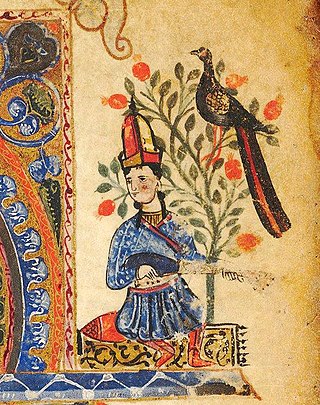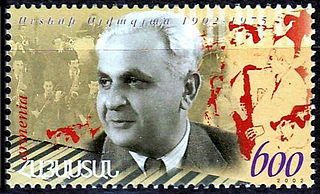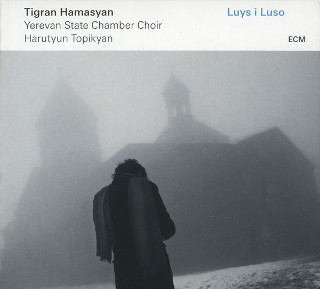
Aram Ilyich Khachaturian was a Soviet Armenian composer and conductor. He is considered one of the leading Soviet composers.

The music of Armenia has its origins in the Armenian highlands, dating back to the 3rd millennium BCE, and is a long-standing musical tradition that encompasses diverse secular and religious, or sacred, music. Folk music was notably collected and transcribed by Komitas Vardapet, a prominent composer and musicologist, in the late nineteenth and early twentieth centuries, who is also considered the founder of the modern Armenian national school of music. Armenian music has been presented internationally by numerous artists, such as composers Aram Khachaturian, Alexander Arutiunian, Arno Babajanian, Haig Gudenian, and Karen Kavaleryan as well as by traditional performers such as duduk player Djivan Gasparyan.
Armenian rock describes a wide variety of forms of rock music made in Armenia or by artists of Armenian descent.

The culture of Armenia encompasses many elements that are based on the geography, literature, architecture, dance, and music of the Armenian people. Armenia is a majority Christian country in the Caucasus.

Alexander Grigori Arutiunian, was a Soviet and Armenian composer and pianist, widely known for his 1950 Trumpet Concerto. A professor at Yerevan State Conservatory, he was recognized with many awards for his work, including the Stalin Prize in 1949 and People's Artist of the USSR in 1970, as well as numerous honors from his homeland of Armenia.
Arto Tunchboyachyan is an Armenian American avant-garde folk and jazz multi-instrumentalist and singer of Armenian descent. He fronts his own group called the Armenian Navy Band, and is also a member of the instrumental quartet Night Ark.
Armen Hrant Donelian is a jazz pianist, composer, educator and author.

Komitas State Conservatory of Yerevan, also known as Yerevan Komitas State Conservatory (YKSC) or Yerevan State Conservatory (YSC), is a state-owned college of music located in Yerevan, Armenia. The institute was founded in 1921 as a music studio. In 1923, it was turned into a higher musical education institution. It is named after Komitas, the founder of the Armenian national school of music.

Artemi (Harutyun) Ayvazyan was a Soviet Armenian composer, conductor, founder of the Armenian State Jazz Orchestra, and People's Artist of Armenia (1962).

Konstantin Aghaparonovich Orbelyan was an Armenian pianist, composer, head of the State Estrada Orchestra of Armenia.

Tigran Hamasyan is an Armenian jazz pianist and composer. He plays mostly original compositions, strongly influenced by the Armenian folk tradition, often using its scales and modalities. In addition to this folk influence, Hamasyan is influenced by American jazz traditions and, to some extent, as on his album Red Hail, by progressive rock. His solo album A Fable is most strongly influenced by Armenian folk music. Even in his most overt jazz compositions and renditions of well-known jazz pieces, his improvisations often contain embellishments based on scales from Middle Eastern/Southwest Asian traditions.
The Gurdjieff Folk Instruments Ensemble based in Armenia was founded in 2008, and is led by the Armenian musician, Levon Eskenian. The Ensemble’s awards include the prestigious Dutch Edison Award: Best World Music Album 2012 and Armenian National Music Award: Best Folk Music Album 2011, for their album, “Music of Georges I. Gurdjieff,’’ produced by ECM Records. The ensemble consists of Armenia’s leading practitioners of traditional music performing on Duduk, Blul, Kamancha, Oud, Kanōn, Santur, Tar/Saz, Dap/Daf, Dhol, and Tombak. The repertoire is composed of the “mystic and spiritual teacher,” George I. Gurdjieff's Armenian, Greek, Assyrian, Arabic, Kurdish, Caucasian spiritual and folk music, authentically arranged for Eastern instruments by Eskenian. The repertoire also includes additional Eastern music that exemplifies Gurdjieff’s musical influences during his travels in the East.
This is a timeline documenting events of Jazz in the year 1902.

Swallow Music Awards is an annual national music awards ceremony first held in Yerevan, Armenia, on 25 March 2017. The awards are created and sponsored by RA Ministry of Culture to appreciate and spur the activities of individuals and creators of various genres of Armenian musical art, as well as to display the significant achievements in the field of music to the broader layers of society. The awards consist of four parts: achievements in classical genre, folk genre, mass pop genre, and special/other awards. During the ceremony artists are given the awards designed by Armenian painter and designer Arman Nur. Each year, the award ceremony airs live on Public Television company of Armenia.

The Tchaikovsky Secondary Music School, is a secondary school in Yerevan, Armenia which opened in 1939. The school is a specialized secondary school where a total of 600 students are enrolled in a 12-year education, while at the same time receiving 2 certificates of general and vocational education. Over 70 percent of the school's alumni attend the Komitas State Conservatory of Yerevan.

Luys i Luso is the seventh album by Armenian pianist Tigran Hamasyan. It was released to commemorate the 100th anniversary of the Armenian genocide.

Levon Malkhasyan, also known as Malkhas, is an Armenian jazz musician, composer and pianist, one of the founders of the Armenian jazz scene, and owner of Malkhas Jazz Club.











